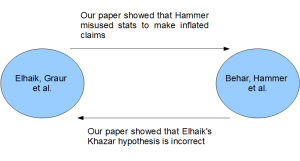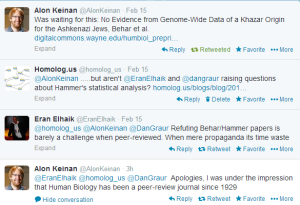
No Genomic Evidence of Khazar Origin for the Ashkenazi Jews?
Last year, we wrote about Eran Elhaik’s paper in -
New Study Sheds Light on the Origin of the European Jewish Population
Population Genetics Study on Khazar Origin of Jews is Back in Spotlight
Those blog posts and other news reports about Elhaik’s work were followed by some drama, when Elhaik claimed that Google moved his Johns Hopkins webpage away from its top hit. Miraculously the page came back on top after he raised enough hell, and we have no idea how and why. Those were pre-Snowden days, when Google was seen as a ‘do no evil’ company and we decided to argue in favor of software problems and not malicious intents.
Anyway, we really do not care about the political aspects of his population genetics study and would rather like to get the truth being properly reflected, no matter where the truth lies. Therefore, we like to mention a new paper available from Human Biology website that attempts to refute Elhaik’s claims. Alon Keinan (?@AlonKeinan) pointed us to this study.
No Evidence from Genome-Wide Data of a Khazar Origin for the Ashkenazi Jews
The origin and history of the Ashkenazi Jewish population have long been of great interest, and advances in high-throughput genetic analysis have recently provided a new approach for investigating these topics. We and others have argued on the basis of genome-wide data that the Ashkenazi Jewish population derives its ancestry from a combination of sources tracing to both Europe and the Middle East. It has been claimed, however, through a reanalysis of some of our data, that a large part of the ancestry of the Ashkenazi population originates with the Khazars, a Turkic-speaking group that lived to the north of the Caucasus region ~1,000 years ago. Because the Khazar population has left no obvious modern descendants that could enable a clear test for a contribution to Ashkenazi Jewish ancestry, the Khazar hypothesis has been difficult to examine using genetics.
Furthermore, because only limited genetic data have been available from the Caucasus region, and because these data have been concentrated in populations that are genetically close to populations from the Middle East, the attribution of any signal of Ashkenazi-Caucasus genetic similarity to Khazar ancestry rather than shared ancestral Middle Eastern ancestry has been problematic. Here, through integration of genotypes on newly collected samples with data from several of our past studies, we have assembled the largest data set available to date for assessment of Ashkenazi Jewish genetic origins. This data set contains genome-wide single-nucleotide polymorphisms in 1,774 samples from 106 Jewish and non- Jewish populations that span the possible regions of potential Ashkenazi ancestry: Europe, the Middle East, and the region historically associated with the Khazar Khaganate. The data set includes 261 samples from 15 populations from the Caucasus region and the region directly to its north, samples that have not previously been included alongside Ashkenazi Jewish samples in genomic studies. Employing a variety of standard techniques for the analysis of populationgenetic structure, we find that Ashkenazi Jews share the greatest genetic ancestry with other Jewish populations, and among non-Jewish populations, with groups from Europe and the Middle East. No particular similarity of Ashkenazi Jews with populations from the Caucasus is evident, particularly with the populations that most closely represent the Khazar region. Thus, analysis of Ashkenazi Jews together with a large sample from the region of the Khazar Khaganate corroborates the earlier results that Ashkenazi Jews derive their ancestry primarily from populations of the Middle East and Europe, that they possess considerable shared ancestry with other Jewish populations, and that there is no indication of a significant genetic contribution either from within or from north of the Caucasus region.
We asked Elhaik about the above paper and he mentioned that it is on a ‘preprint server’. Therefore, it is too early for him to comment on until the study is available in a published format. He also pointed us to his recently published paper with Dan Graur, where he showed that Hammer’s group made faulty statistical analysis to make an inflated claim. We are utterly confused by all these (see figure below) and would like to hand over this mess to Lior Pachter :)

